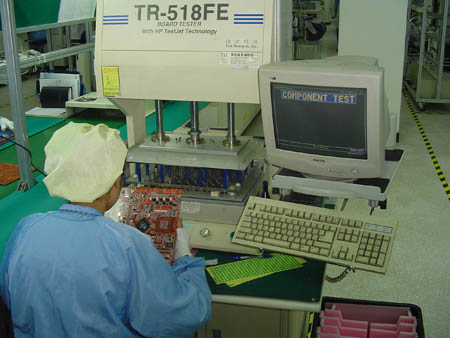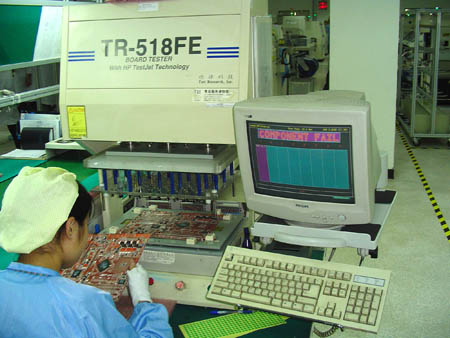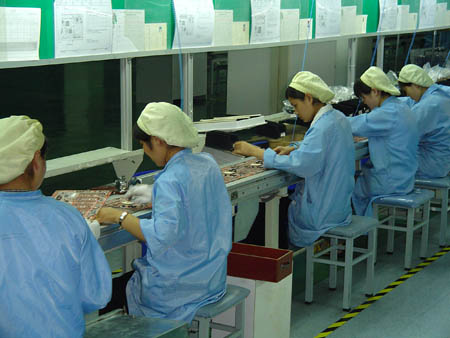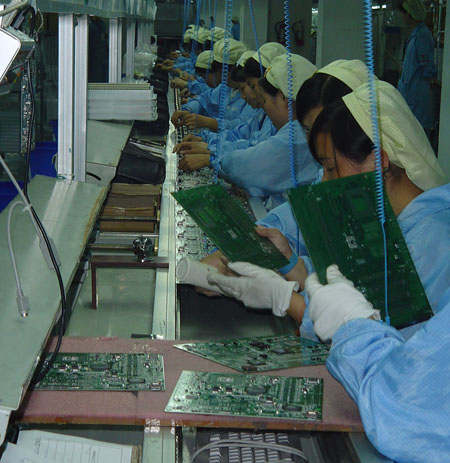The Birth of an Abit NF7 - A Factory Tour
by Kristopher Kubicki on June 11, 2004 10:12 PM EST- Posted in
- Motherboards
Assembly
On average, 1.4 out of 100 motherboards fail Rolly's quality assurance standards. These boards never leave the factory, but the cost of the components and manpower put into the motherboard are lost and translated onto the retail price. Efficiency of 98.6% is about average for a factory of this size. Although, Abit told us in the next several months that they are increasing funding to several projects,which should get this number closer to 99%. About 150 of the factory's 1400 employees are allocated solely to quality assurance testing.Above, you can see a specialized machine electrically testing the newly stamped SMDs on the motherboard. It is assumed that the PCB from the OEM is working correctly, so this is the first electrical test in the assembly process. Unfortunately, this poor NF7 does not pass inspection, even after several tries. The inspector places this board in a separate bin and it is sent to a reworking station where it undergoes manual electrical testing under oscilliscopes. The much higher skilled workers who test individual components with scopes are trained to solder or strip down a board depending on whether or not it can be reworked. Only after this stage does a bad motherboard get completely pitched. A short clip of an engineer testing a defunct board can be viewed below.
After successfully passing the first visual and electrical inspection tests, the half completed motherboard moves down to the epoch of manual labor - the assembly line. Here, 30 to 40 workers sit on the assembly line and plug components too large for SMT into the motherboard. This includes components like PCI slots, DIMM slots, capacitors, audio connectors, and anything big enough to place easily with your fingers. All of these components slide into the holes predrilled into the PCB before it comes to the factory. As we mentioned in the ECS factory tour, assembly workers are primarily female. In this particular region of the world, women usually work for less and are proven to have higher concentration at tasks such as small component assembly.
Again, you can see above the amount of manual labor used to plug components into the motherboard. Every few stations or so, a worker uses a barcode scanner to scan the board into a centralized Oracle database. Each board is tracked stringently via this system, which is also connected globally. Managers in Abit's USA or Taiwan office can watch a board undergo each stage of construction in their office via the Oracle database interface. This system also provides excellent backtracking if a board is found later to have faulty components or poor assembly. The idea is to control quality with the highest standards, and then refine the process as quickly as possible so that no boards in the future are corrupted.















19 Comments
View All Comments
fengpc - Sunday, August 22, 2004 - link
Visited Suzhou two times, it's a nicer area than ShenZhen IMO. The industry zones look cleaner and more organized. However I believe they will have power issues just like other mfg zones in China soon. Nice article, enjoy reading it.KristopherKubicki - Wednesday, June 16, 2004 - link
http://images.anandtech.com/reviews/motherboards/a...Kristopher
Glenngalata - Wednesday, June 16, 2004 - link
An excellent overview of what is involved in the motherboard manufacturing world.The key point to this article is the availability of cheap labor. There would never be a way to produce an American made motherboard product that would be cost effective against the the far east produced items which is unfortunate.
Another key point to the article is the comment of the ABIT quality control being obviously tighter than that of ECS. Anyone who has owned an ECS product can attest to the fact that the lemon rate for their products distinctly shows the quality difference going against ECS. They may be a larger company but they did not get there by catering to buyers who care about any level of satisfaction. Maybe this is why ECS was voted one of the worst quality control entities in the entire motherboard segment.
The choice is yours but ABIT scored my vote on this one.
MadAd - Wednesday, June 16, 2004 - link
yeah please, whats the url?KristopherKubicki - Tuesday, June 15, 2004 - link
14: I have it - its 23MB though. send me an email, i will drop it somewhere you can pick it up.Kristopher
manzana - Tuesday, June 15, 2004 - link
Interesting article. Wish there was a video of that person building the pc within 1 minute ;)araczynski - Monday, June 14, 2004 - link
very nice article, makes me miss my days in the industrial automation field, but not the pressures :)KristopherKubicki - Monday, June 14, 2004 - link
Jaramin,Like i said in the ECS article also, workers work about 8 to 9 hours a day and are provided with meals/housing. There is very little variation between any company that operates out of China; its kind of all about standardized. If you have any other specific political or economic questions feel free to ask.
Kristopher
Jaramin - Monday, June 14, 2004 - link
It would be nice if some more information about the ethical or human ressource aspect of the manufacture would be included. The only thing that was provided here is that the workers are paid 100$/month...Some of us like to know what is the actual human cost of a product. Knowing that company A offers better working conditions than B could certainly weight on my choice of boards.
ViRGE - Monday, June 14, 2004 - link
While I don't really have anything of substance to say, I would like to say that this is one of those "wow, that's cool" kind of articles that are always great to see. Kudos for doing these kinds of things, guys.